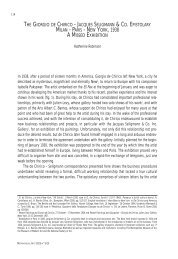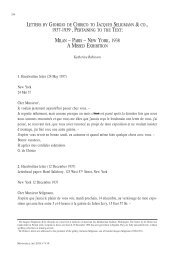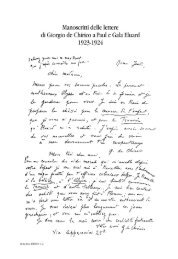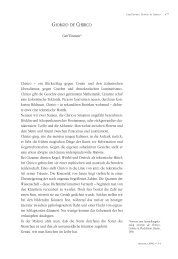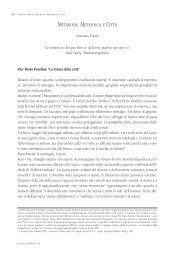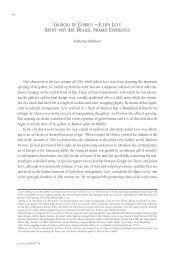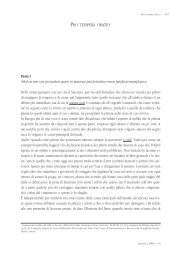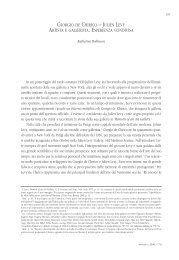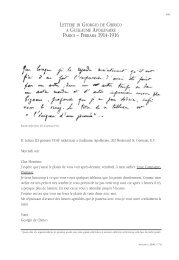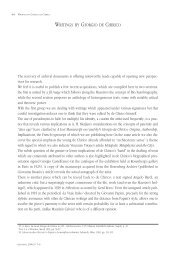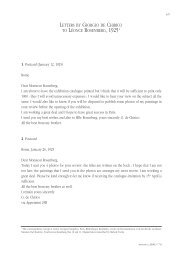Emplastic Oil - Fondazione Giorgio e Isa de Chirico
Emplastic Oil - Fondazione Giorgio e Isa de Chirico
Emplastic Oil - Fondazione Giorgio e Isa de Chirico
Create successful ePaper yourself
Turn your PDF publications into a flip-book with our unique Google optimized e-Paper software.
176<br />
SALVATORE VACANTI: FROM MURAL PAINTING TO “EMPLASTIC OIL”<br />
I am happy that the emulsion is going well. You are right, we must keep it secret […] try this formula<br />
which seems to give better results in oiliness, pastiness, and transparency, etc. Take one small spoonful<br />
of cooked linseed oil, and add two spoonfuls of carpenter glue drop by drop while stirring. In the<br />
evening, put some strong glue to soak in water. The next day melt it in a double boiler and add a bit<br />
of vinegar. 76<br />
During these years, <strong>de</strong> <strong>Chirico</strong> also attempted sculpture for the first time. In 1940 while in<br />
Florence, he produced his first terracotta works with the restorer Alietti. The subject matter of these<br />
sculptures sum up the creations of many years of artistic activity. His i<strong>de</strong>as on the subject were clear,<br />
and he expressed them in his programmatic text Brevis pro plastica oratio, in which he states:<br />
If a sculpture is hard it is not sculpture. Sculpture must be soft and warm, and it must have all the softness<br />
and the colours of a painting: a beautiful sculpture is always painterly. 77<br />
His first works were executed in clay, an easily malleable material that the artist could mould<br />
and shape similarly to the stroke of a pencil on paper. His approach to sculpture was a natural<br />
<strong>de</strong>velopment of the material research that characterised his painting; herein lay <strong>de</strong> <strong>Chirico</strong>’s need<br />
to colour his small terracottas like the “Ancients” had. 78<br />
Whilst the critics seemingly rejected his work, <strong>de</strong> <strong>Chirico</strong> continued to <strong>de</strong>nounce the entire art<br />
world, strongly con<strong>de</strong>mning “mo<strong>de</strong>rnist painting”. The early years of the Second World War were<br />
prolific in terms of artistic production and theoretical research, which <strong>de</strong> <strong>Chirico</strong> revealed in interviews<br />
and written works, in which he related the perfecting of his aesthetic. In an article<br />
Consi<strong>de</strong>razioni sulla pittura mo<strong>de</strong>rna (Consi<strong>de</strong>rations on Mo<strong>de</strong>rn Painting) 79 of January 1942 <strong>de</strong><br />
<strong>Chirico</strong> stated that the true painter is not obliged to “finish the painting”, legitimising thus the free<br />
and loose brushstrokes that characterised his 1940s production. This position contrasted dramatically<br />
with the i<strong>de</strong>a of finiteness in painting that he had endorsed in the past. The same year he published<br />
Discorso sulla materia pittorica (Discourse on the Material Substance of Paint), in which he<br />
<strong>de</strong>clared once again his faith in “beautiful painting”. The text <strong>de</strong>monstrates <strong>de</strong> <strong>Chirico</strong>’s philosophical<br />
belief in an inextricable fusion between material and image:<br />
This painterly material, which is the substance of painting, is composed of two elements that are equally<br />
important and absolutely inseparable: physical substance and metaphysical substance. These two<br />
elements complete each other and, when they are of superior quality, create a masterpiece by way of<br />
their absolute harmony. 80<br />
76<br />
Letter from 1940, published in Gli anni Trenta, cit., p. 301<br />
77<br />
G. <strong>de</strong> <strong>Chirico</strong>, Brevis pro plastica oratio, in “Aria d’Italia”, Milan, Winter 1940; now in G. <strong>de</strong> <strong>Chirico</strong>, Scritti/1…, cit., pp. 890-892.<br />
78<br />
The reactions to <strong>de</strong> <strong>Chirico</strong>’s first sculpture exhibition held in March 1941 in Milan’s Galleria Barbaroux were conflicting. For <strong>de</strong>chirican sculpture<br />
see: De <strong>Chirico</strong> scultore, G. dalla Chiesa ed., Mondadori, Milan 1988; Il gran<strong>de</strong> metafisico: G. <strong>de</strong> <strong>Chirico</strong> scultore, exhibition catalogue, F. Ragazzi ed.,<br />
Electa, Milan 2004.<br />
79<br />
G. <strong>de</strong> <strong>Chirico</strong>, Consi<strong>de</strong>razioni sulla pittura mo<strong>de</strong>rna, in “Stile”, Milan, January 1942: reprinted in “Il Corriere Padano”, Ferrara, March 1, 1942; now in<br />
G. <strong>de</strong> <strong>Chirico</strong>, Scritti/1 …, cit., pp. 433-455.<br />
80<br />
G. <strong>de</strong> <strong>Chirico</strong>, Discorso sulla materia pittoria, in “Il Corriere Padano”, Ferrara, 5 April 1942; republished in “L’Illustrazione Italiana”, Milan, 26 April<br />
1942; now in G. <strong>de</strong> <strong>Chirico</strong>, Scritti/1…, cit., pp. 456-467<br />
METAPHYSICAL ART 2010|N° 9/10



